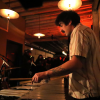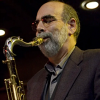Home » Jazz Articles » Live Review » Chris Oatts Quintet featuring Terell Stafford at Chris’ ...
Chris Oatts Quintet featuring Terell Stafford at Chris’ Jazz Café
Chris' Jazz Café
Live and Streaming
Philadelphia, PA
September 10, 2021
This was the reviewer's first time at a live performance in a jazz club since the start of the corona virus pandemic a year and a half ago. A few weeks before, Chris' Jazz Café, the iconic downtown Philadelphia jazz club, re-opened to live performances. The pandemic is still evidenced by masks being worn by the audience and staff. People were required to show proof of vaccination. And individuals were seated quite a distance apart, except if they came as a group. This health-necessitated arrangement took away from the excitement of a crowded-in group of fans, but it was good that there were less of clinking glasses and loud conversation than in the past. Also -presumably as a result of technical upgrades for livestream—the sound system was near-perfect, making the listening experience terrific. And a spanking new Yamaha grand piano didn't hurt either.
We've all been following trumpeter Terell Stafford for many years, and many of us have more recently been checking out saxophonist Chris Oatts, one of his former students from Temple University and the nephew of the legendary saxophonist Dick Oatts. It was a great move to bring them together, reminiscent of a day when more mature musicians would help bring up the younger generation by having them on gigs. In this case, it was the reverse. Oatts brought with him a great rhythm section of Tim Brey on piano, Sam Harris on bass, and Anwar Marshall on drums. And Stafford served as featured artist. Oatts and Stafford have distinctly different approaches to the music: Oatts is beautifully imaginative yet under control, and Stafford is brilliant, virtuosic, and at times threatening to break loose from his moorings. Yet their mutual in-depth familiarity with a variety of jazz idioms gives them mutual understanding, complementing each other very well. Stafford stayed on unmuted trumpet throughout. Oatts played alto and on some tunes, soprano saxophone.
The set began with a Jimmy Van Heusen standard, "Personality," with Oatts' arrangement and workout on alto saxophone giving the piece a conversational swing. Stafford delivered super fast runs at which he excels, maintaining precision and sonority. Oatts and his pianist, the ubiquitous Tim Brey, structured the music in creative ways. Bassist Harris kept the group in a common rhythmic groove. Drummer Marshall, as Elvin Jones said and exemplified, treated the drum set as a single musical instrument, providing not only the impulse (no pun intended), but a rich mixture of all the drum sounds, that provided wholeness and complexity to the action.
"Dragon Night" is an Oatts original, in a version featuring him on soprano saxophone. It was played as an evocative upbeat blues; Oatts' tone and technique on soprano saxophone makes him a contender for one of the very best on this instrument that John Coltrane took to new places. This piece was where we saw Oatts pushing the envelopes of concepts, compositions, and instrumental savvy to new places. Oatts shines. If he eventually transcends the boundaries while maintaining his own voice, he has the potential to move into jazz greatness. We shall see (or, rather, hear).
In Richard Rogers' "Bewitched, Bothered, and Bewildered," Oatts and especially Stafford play around and have fun with the statement of this well-known melody. Brey's piano does a lot to keep the piece in synch, with bass line and chords in the left hand and single lines in right like Red Garland and Wynton Kelly with the Miles Davis groups. There was a great drum solo by Marshall, where you could really hear the remarkable (maybe say "organic") sounds he makes while improvising with the whole drum set. Harris' bass very much selflessly comped for the others, but he did offer a tightly disciplined solo, as the rhythm section worked to bring Oatts and Stafford back to normal.
"He Knows How Much We Can Bear" is a traditional hymn sung in one version by Mahalia Jackson presented in an arrangement by Stafford that has little feeling of a hymn until the last statement of the melody. The way in which he reworked the song suggests that he is more interested in the notes and the harmonic progression as a vehichle and less about its church function or meaning. The same applied to Oatts, who did a great solo on this one, reharmonizing it along the way.
The set concluded with a lively version of Oatts' own "Alley Birds," a tune that along with other of his compositions, has a good chance of becoming a jazz standard, always with strong ties to bebop and hard bop, but updated just enough to satisfy the more serious listeners. All the musicians took assertive solos on this one, and Oatts and Stafford co-improvised towards the end, something you wished they'd done more of.
As everything becomes more digitalized and virtual, live, in-person jazz in a small intimate setting is going to be increasingly at risk. Coming back to this setting after a COVID hiatus reminded this reviewer how much there is no substitute for "the real thing." As these clubs reopen, please give them all the support you can while "staying safe."
Set List: Personality (von Heusen); Dragon Night (C. Oatts); Bewitched, Bothered, and Bewildered (Rodgers); He Knows How Much We Can Bear (Traditional Hymn; arr/ Stafford); Alley Birds (C. Oatts).
Personnel: Chris Oatts: alto and soprano saxophones, leader; Terell Stafford: trumpet; Tim Brey: piano; Sam Harris: bass;; Anwar Marshall: drums.
Tags
Live Review
Chris Oatts
Victor L. Schermer
United States
Pennsylvania
Philadelphia
Terell Stafford
Tim Brey
Sam Harris
Anwar Marshall
Jimmy Van Heusen
Red Garland
Wynton Kelly
Miles Davis
Mahalia Jackson
Chris' Jazz Cafe
PREVIOUS / NEXT
Support All About Jazz
 All About Jazz has been a pillar of jazz since 1995, championing it as an art form and, more importantly, supporting the musicians who make it. Our enduring commitment has made "AAJ" one of the most culturally important websites of its kind, read by hundreds of thousands of fans, musicians and industry figures every month.
All About Jazz has been a pillar of jazz since 1995, championing it as an art form and, more importantly, supporting the musicians who make it. Our enduring commitment has made "AAJ" one of the most culturally important websites of its kind, read by hundreds of thousands of fans, musicians and industry figures every month.





























